La capacità di dare vita e rappresentare tutto ciò che è in grado di andare oltre la realtà oggettiva, costituisce un’importante parte creativa che per alcuni artisti diviene unico modo per lasciar fuoriuscire una naturale inclinazione attraverso cui permettere a se stessi, e all’osservatore, di immergersi in dimensioni nuove, inaspettate e tuttavia coinvolgenti proprio per quell’apparenza fantastica e indefinita che mostrano. Il protagonista di oggi si spinge verso terreni inesplorati sia dal punto di vista figurativo che da quello dello stile che si pone come una reinterpretazione e un superamento delle tracce del passato mescolate con uno sguardo presente che sceglie di evadere per inoltrarsi nell’universo della fantasia.
L’inizio del Ventesimo secolo fu letteralmente un turbinìo di tentativi per contrastare tutte le linee guida accademiche che contraddistinsero l’arte precedente, accogliendo gli spunti delle prime rivoluzioni stilistiche avvenute con l’Impressionismo e i primordi dell’Espressionismo, trasformandoli e adattandoli a nuove sperimentazioni volte a sottolineare la supremazia della manifestazione creativa sulla realtà osservata o, in altri casi, l’adeguamento a una contemporaneità sociale in continua modificazione e accelerazione e dunque lontana dall’approccio più classico e formale dell’Ottocento. Ciò su cui molti movimenti di quei vivaci primi anni del Novecento convergevano fu la scomposizione dell’immagine osservata, ampliando e modificando l’intuizione degli impressionisti, e degli aderenti ai successivi Puntinismo e al Divisionismo; furono quelle le basi da cui poi, con maggiore audacia e desiderio di mettere in discussione le conoscenze precedenti, si svilupparono il Futurismo e il Cubismo. Entrambi orientati alla suddivisione delle immagini in parti ben definite e quasi geometriche, mostrarono tuttavia caratteristiche differenti perché laddove il Cubismo infondeva nell’osservatore il senso di simultaneità dell’immagine che però appariva ferma, fissata sulla sensazione dell’autore dell’opera, il Futurismo invece impostava tutta la sua intenzione pittorica sul movimento, quella velocità affine ai rivoluzionari tempi moderni che stavano modificando l’intero modo di vivere delle persone. Le scoperte tecnologiche, le produzioni in serie, un positivismo generato proprio dalla consapevolezza di poter fare ancora molto e la fiducia nel futuro erano le basi del Futurismo, contraddistinto da immagini spezzettate e reiterate per dare l’idea dell’accelerazione di quel periodo; se da un lato Filippo Tommaso Marinetti e Giacomo Balla assunsero una figurazione più spigolosa, rigorosa quasi, dall’altro Umberto Boccioni optò invece per una maggiore morbidezza di forme e cromatica, spingendosi verso una visionarietà che andava oltre la scomposizione. Eppure nel Futurismo vi era ancora un contatto con la figurazione superato nei coevi movimenti che invece scelsero come linee guida la totale assenza di qualsiasi riferimento a tutto ciò che l’occhio poteva cogliere, per affermare l’assoluto predominio del gesto plastico su qualsiasi connessione soggettiva e oggettiva; parlo ovviamente dell’Astrattismo, a volte più morbido e curvilineo con elementi riconducibili in qualche modo a sensazioni indefinite, come nell’Astrattismo Lirico, altre in vece più rigoroso e schematico come nel Suprematismo e nel Neoplasticismo.
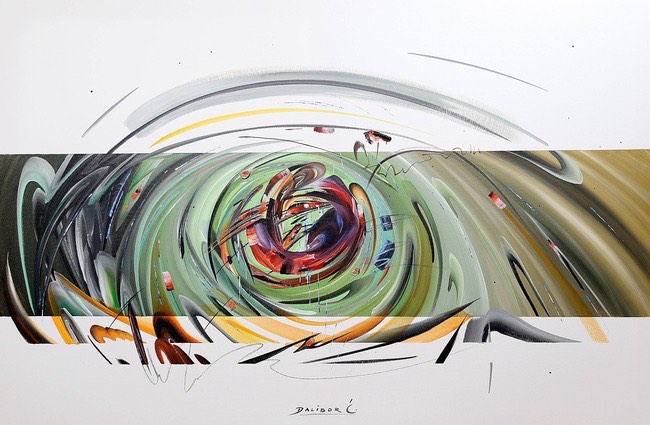
Il linguaggio pittorico dell’artista montenegrino Dalibor Dado Ćetković mescola il senso del movimento del Futurismo a una tendenza più astratta, quasi come se le linee che contraddistinguono le sue opere fossero un filo di congiunzione tra ciò che può essere intravisto e ciò che invece viene immaginato; la gamma cromatica è chiara, elegante, cristallina, perché in fondo le atmosfere sussurrate dall’artista tendono verso la luminosità per rappresentare una fiducia nell’inconoscibile che in questo caso non ha accezioni negative, piuttosto illustra inedite possibilità e opzioni potenzialmente favorevoli per uscire dalla quotidianità. Attraverso le sue tele emerge una riflessione di Ćetković, quella che l’essere umano è talmente abituato alla realtà in cui vive da dimenticare che questa è solo una tra quelle possibili, introducendo il concetto quantico dei molti mondi paralleli tra cui scegliere di vivere.
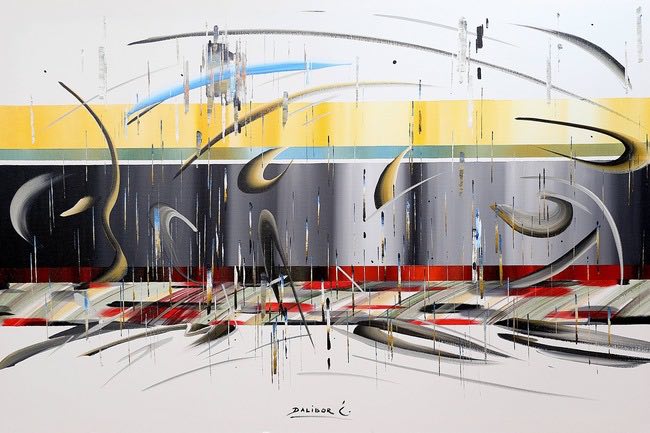
E allora l’artista sembra voler indicare quelle impensabili opzioni, quel modo nuovo di osservare ciò che va a comporre i tasselli dell’esistenza, frammentarli e decontestualizzarli per giungere a un’inedita ricostituzione, confusa e indefinita eppure altrettanto potenzialmente verosimile e funzionale a spiegare concetti e moti interiori. Dalibor Dado Ćetković alterna segni definiti a riquadri geometrici dentro cui inserire a volte dei semplici sfondi per lasciar emergere in maniera più chiara le forme in superficie, altre invece elementi che si armonizzano ed enfatizzano le immagini evocate dai titoli.
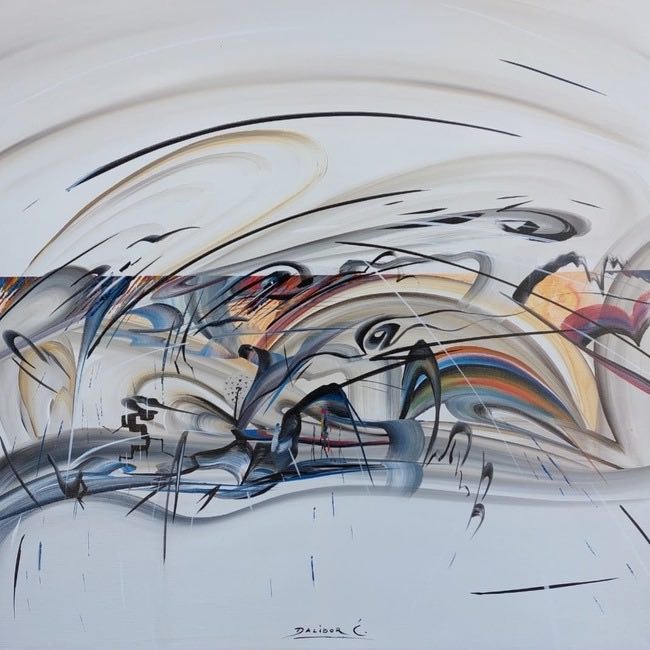
La stilizzazione appare più intensa quando l’artista racconta di mondi e di animali fantastici, più astratta quando invece entra nella sfera delle emozioni legate all’interiorità oppure ad argomenti di attualità per sensibilizzare l’osservatore, ma in entrambi i casi il risultato è un coinvolgimento totale perché lo sguardo va a cercare il riferimento suggerito con il titolo e che Ćetković lascia emergere in maniera indistinta ma in fondo distinguibile.
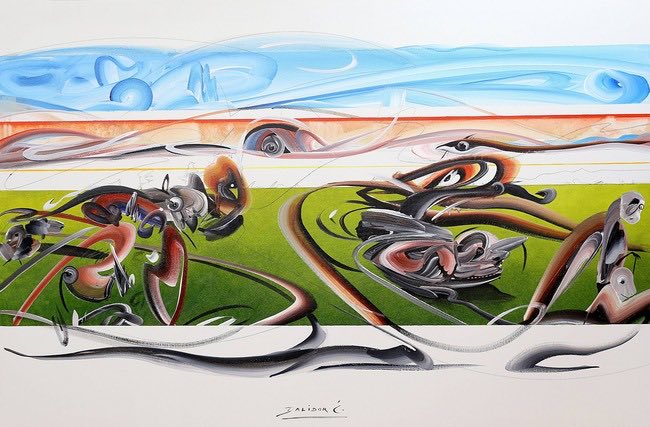
L’opera Story after story conduce verso una dimensione surreale, inesistente eppure incredibilmente affascinante perché spinge la mente a cercare un riferimento nella realtà quotidiana, lo sguardo cerca di individuare quelle inconsuete creature che l’artista sceglie per raccontare una favola postmoderna, forse priva di esseri umani o forse invece una dimensione in cui l’uomo ha trasformato la sua sembianza per diventare altro da sé. In qualche modo fuoriesce un monito di Ćetković a non perdere ciò che contraddistingue l’individuo e cioè la sua umanità, la sua emozione, perché diversamente potrebbe trovarsi a non avere più la coscienza e la consapevolezza che lo differenziano da un animale, da un insetto, o da qualsiasi altro essere vivente ma non pensante.

E ancora in Road l’opera indica un percorso, una direzione da seguire per raggiungere il proprio obiettivo, malgrado sia lunga e non si veda il punto di arrivo ciò che è importante è cominciare a intraprenderla, a dirigersi verso quell’infinito che potrà anche essere pieno di deviazioni e di ostacoli, ma in fondo tutti necessari per comprendere se stessi e per continuare a credere che sia possibile giungere al termine del cammino; o forse ciò che Dalibor Dado Ćetković sottintende è che non vi sia una fine perché l’essere umano ha bisogno di avere uno scopo, solo così potrà mantenere viva la sua curiosità e il suo desiderio di misurarsi con i propri limiti. I segni indefiniti alla base dell’opera costituiscono i dubbi e le perplessità, i timori che molto, troppo spesso, inducono le persone a restare immobili all’interno della propria zona sicura; eppure superandola, oltrepassando quella gabbia dentro cui ci si rifugia, si può trovare molto di più rispetto a ciò che si sta lasciando.
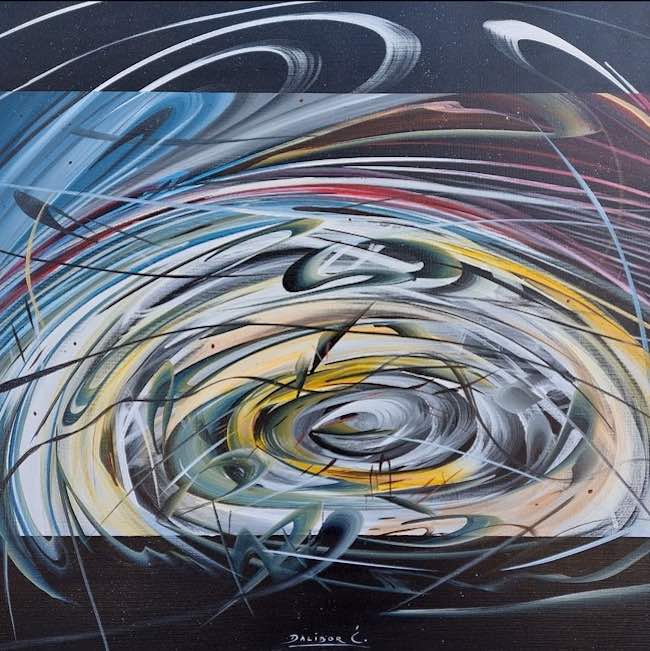
Quando entra nel mondo delle emozioni invece l’artista si sposta verso un’astrazione quasi totale, come nel dipinto Hurricane of thoughts in cui il riquadro non riesce a contenere il groviglio di sensazioni, di idee, di pensieri che si intrecciano dando origine al caos; ma il caos, sembra suggerire Ćetković, è alla base dell’ordine, è quell’elemento grazie a cui la conoscenza si evolve e a seguito del quale emerge una nuova chiarezza, una consapevolezza che nel momento di destabilizzazione sembrava impossibile raggiungere. Qui le linee sono assolutamente curve, la gamma cromatica vira sulle tonalità dell’azzurro che si associa alla ricerca, al naturale tendere verso l’interiorizzazione e la riflessione che alla fine dona pace, sicurezza, rilassatezza; anche in questo caso emerge l’atteggiamento positivo dell’artista, quella capacità di analisi che conduce sempre verso una speranza, una possibilità migliore di quanto previsto inizialmente.
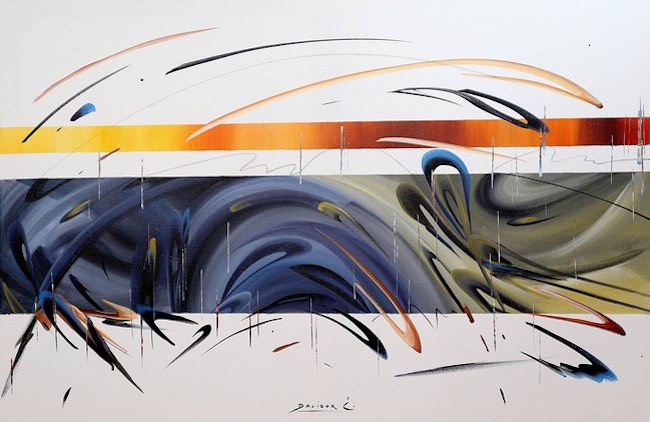
In Ecosystems infatti affronta un argomento delicato, quello del mondo attuale in cui per interessi economici di pochi si va a destabilizzare un equilibrio perfetto che invece dovrebbe essere rispettato poiché il suo crollo provocherebbe conseguenze all’intero globo; ma forse in fondo la natura è più forte dei danni che l’uomo può provocare, sa rigenerarsi e trovare un nuovo modo per sopravvivere e rinascere, ed è questo il concetto indicato dall’artista in questo dipinto ed enfatizzato da quei segni grafici che fuoriescono dallo schema principale. Dalibor Dado Ćetković, pittore accademico diplomato presso l’Accademia d’Arte di Trebinje in Bosnia-Erzegovina, è membro dell’Associazione delle Belle Arti del Montenegro, ha esposto e collaborato con gallerie in Arizona, Usa, ha al suo attivo la partecipazione a molte mostre collettive e fiere internazionali, ricevendo premi e riconoscimenti a Los Angeles, Firenze e Palermo. Le sue opere sono inserite in importanti annuari d’arte contemporanea e fanno parte di collezioni private in molte nazioni del mondo.
DALIBOR DADO ĆETKOVIĆ
Email: dalibordadoc@gmail.com
Sito web: https://daliborart.wordpress.com/
Facebook: https://www.facebook.com/dalibordado.cetkovic
Facebook page: https://www.facebook.com/ateljedaliborcetkovic/
Instagram: https://www.instagram.com/dalibordadocetkovic_artist/
YouTube: https://www.youtube.com/channel/UCj4YEihUSEplf3A8xw1I29Q
Suspended realities and imaginary worlds in the Abstract Neofuturism of Dalibor Dado Ćetković
The ability to bring to life and represent all that is capable of going beyond objective reality constitutes an important creative part that, for some artists, becomes the only way to let loose a natural inclination through which they, and the observer, can immerse in new, unexpected and yet enthralling dimensions precisely because of the fantastic and indefinite appearance they display. Today’s protagonist pushes towards unexplored terrain both from a figurative point of view and from that of style, which stands as a reinterpretation and an overcoming of the traces of the past mixed with a present-day gaze that chooses to escape into the universe of fantasy.
The beginning of the twentieth century was literally a whirlwind of attempts to counter all the academic guidelines that characterised previous art, taking the cues from the first stylistic revolutions that occurred with Impressionism and the beginnings of Expressionism, transforming and adapting them to new experiments aimed at emphasising the supremacy of creative manifestation over observed reality or, in other cases, the adaptation to a social contemporaneity that was constantly changing and accelerating and therefore far removed from the more classical and formal approach of the nineteenth century. What many movements of those lively early years of the 20th century converged on was the decomposition of the observed image, expanding and modifying the intuition of the Impressionists, and of the adherents of the later Pointillism and Divisionism; these were the foundations from which Futurism and Cubism developed, with greater audacity and a desire to question previous knowledge. Both oriented towards the subdivision of images into well-defined, almost geometric parts, they nevertheless displayed different characteristics, because whereas Cubism instilled in the observer the sense of simultaneity of the image, which, however, appeared stationary, fixed on the feeling of the author of the artwork, Futurism instead imposed its entire pictorial intention on movement, that speed akin to the revolutionary modern times that were changing the entire way people lived. Technological discoveries, mass production, a positivism generated precisely by the awareness that much could still be done and faith in the future were the foundations of Futurism, characterised by broken and repeated images to give the idea of the acceleration of that period; if on the one hand Filippo Tommaso Marinetti and Giacomo Balla assumed a more angular, almost rigorous figuration, on the other hand Umberto Boccioni opted for a greater softness of form and colour, pushing towards a visionary nature that went beyond decomposition.
Yet in Futurism there was still a contact with figuration surpassed in the coeval movements that instead chose as their guidelines the total absence of any reference to anything that the eye could grasp, to affirm the absolute predominance of the plastic gesture over any subjective and objective connection; I speak, of course, of Abstractionism, at times softer and more curvilinear with elements that can somehow be traced back to indefinite sensations, as in Lyrical Abstractionism, and at others more rigorous and schematic, as in Suprematism and Neoplasticism. The pictorial language of Montenegrin artist Dalibor Dado Ćetković mixes the sense of the Futurism movement with a more abstract tendency, almost as if the lines that characterise his artworks were a connecting thread between what can be glimpsed and what is imagined; the chromatic range is clear, elegant, crystalline, because after all, the atmospheres whispered by the artist tend towards luminosity to represent a trust in the unknowable that in this case does not have negative meanings, but rather illustrates unprecedented possibilities and potentially favourable options to escape from everyday life. Through his canvases emerges one of Ćetković‘s reflections, that the human being is so accustomed to the reality in which he lives that he forgets that this is only one of many possible worlds, introducing the quantum concept of the many parallel worlds from which to choose to live. And so the artist seems to want to indicate those unthinkable options, that new way of observing what goes to make up the pieces of existence, fragmenting and decontextualising them in order to arrive at an unprecedented reconstitution, confused and indefinite and yet just as potentially verisimilar and functional in explaining concepts and inner motions.
Dalibor Dado Ćetković alternates defined signs with geometric frames within which he sometimes inserts simple backgrounds to allow the surface forms to emerge more clearly, while at other times they are elements that harmonise and emphasise the images evoked by the titles. The stylisation appears more intense when the artist recounts fantastic worlds and animals, and more abstract when he enters the sphere of emotions linked to the interior or to topical subjects in order to make the observer aware, but in both cases the result is total involvement because the gaze goes in search of the reference suggested by the title and which Ćetković allows to emerge in an indistinct but ultimately distinguishable manner. The painting Story after story leads towards a surreal, non-existent yet incredibly fascinating dimension because it pushes the mind to search for a reference in everyday reality, the gaze tries to locate those unusual creatures that the artist chooses to tell a post-modern fable, perhaps devoid of human beings or perhaps instead a dimension in which man has transformed his semblance to become something other than himself. Somehow Ćetković‘s warning not to lose what distinguishes the individual, that is, his humanity, his emotion, because otherwise he might find himself no longer having the consciousness and awareness that differentiate him from an animal, an insect, or any other living but non-thinking being. And again in Road, the artwork indicates a path, a direction to follow to reach one’s goal, even if it is long and one cannot see the point of arrival, what is important is to begin to take it, to head towards that infinity that may be full of detours and obstacles, but in the end all necessary to understand oneself and to continue to believe that it is possible to reach the end of the path; or perhaps what Dalibor Dado Ćetković is implying that there is no end because the human being needs to have a purpose, only then can he keep alive his curiosity and his desire to measure himself against his own limits. The indefinite signs at the base of the painting constitute the doubts and perplexities, the fears that very, too often, lead people to remain motionless within their safe zone; yet by overcoming it, by stepping beyond that cage in which one takes refuge, one can find much more than what one is leaving behind.
When he enters the world of the emotions, however, the artist moves towards an almost total abstraction, as in the painting Hurricane of thoughts in which the frame cannot contain the tangle of sensations, of ideas, of thoughts that intertwine, giving rise to chaos; but chaos, Ćetković seems to suggest, is the basis of order, it is that element thanks to which knowledge evolves and as a result of which a new clarity emerges, an awareness that at the moment of destabilisation seemed impossible to achieve. Here the lines are absolutely curved, the chromatic range turns to shades of blue that are associated with research, with the natural tendency towards interiorisation and reflection that in the end gives peace, security, relaxation; here too emerges the artist’s positive attitude, that capacity for analysis that always leads towards a hope, a better possibility than initially foreseen. In Ecosystems, in fact, he tackles a delicate subject, that of today’s world in which the economic interests of a few are destabilising a perfect equilibrium that should instead be respected because its collapse would have consequences for the entire globe; but perhaps in the end nature is stronger than the damage that man can cause, it knows how to regenerate itself and find a new way to survive and be reborn, and this is the concept indicated by the artist in this painting and emphasised by those graphic signs that emerge from the main scheme. Dalibor Dado Ćetković, an academic painter who graduated from the Trebinje Art Academy in Bosnia and Herzegovina, is a member of the Fine Arts Association of Montenegro, has exhibited and collaborated with galleries in Arizona, USA, and has participated in many group exhibitions and international fairs, receiving awards and recognition in Los Angeles, Florence and Palermo. His artworks are included in important contemporary art yearbooks and are part of private collections in many countries around the world.














